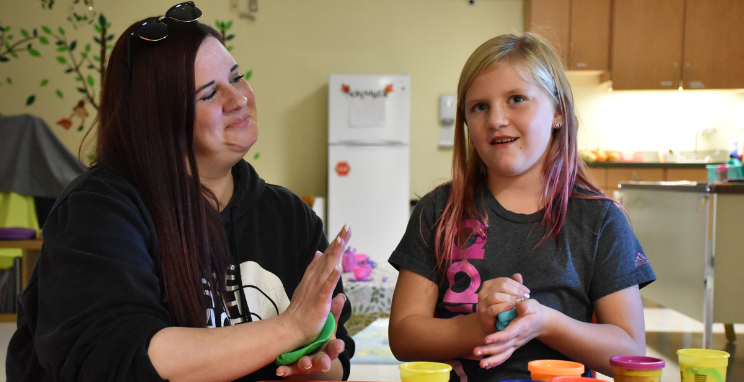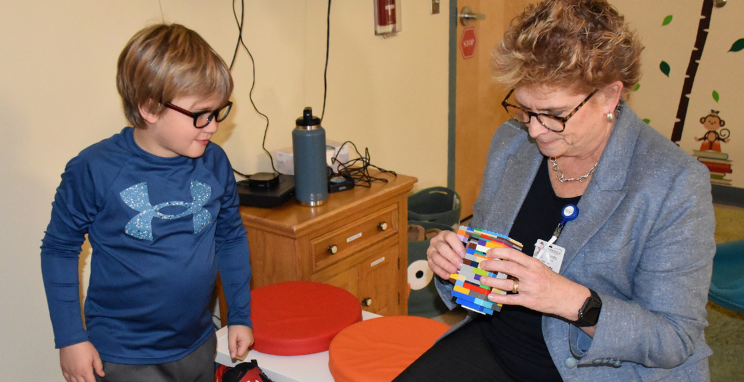“It is the most positive relief I can have as a hospital worker and parent. I know that — no matter what — I can show up to work, even if child care falls through.“
– WellSpan Evangelical staff member
Background: COVID-19 Pandemic Adds Strain to Fragile Child Care System for Hospital Workers
Located in the heart of the Susquehanna River Valley in Lewisburg, Pennsylvania (pop. 5,255), WellSpan Evangelical Community Hospital is a 131-bed hospital that also serves as one of Union County’s largest employers. In 2019, WellSpan Evangelical was operating as an independent community hospital with nearly 2,000 employees. Women made up about 80% of the company’s workforce, and child care was a key topic for employees and leaders alike.
The hospital had a long-term partnership with a local child care partner that offered priority access for hospital employees. But demand for care was rising, and it was becoming more difficult for employees to access care through that partner. Hospital administrators were already considering better ways to support working parents. And then, COVID-19 arrived.
During the height of the COVID-19 lockdowns, the hospital responded to unprecedented school closures and strain on their teams by providing care for school-aged kids: Students participated in virtual school while their parents worked. But even as pandemic-era restrictions eventually eased and children returned to school, the challenges employees faced finding reliable child care didn’t let up. Hospital leaders wanted to provide staff with a dedicated traditional child care facility in collaboration with the community, but they also knew that such a goal would take years to accomplish. They turned their focus to providing a backup child care option that would provide much needed relief for front-line employees far sooner. And they found a partner to help.
Solution: Find a Partner That Knows the Child Care Business
WellSpan Evangelical is a premier health care facility, not a child care provider.
“We wanted to be part of the solution, but we didn’t want to be running our own child care facility. That is not our core business,” says Kendra Aucker, senior vice president of WellSpan’s north region and president of WellSpan Evangelical.
Hospital leaders also knew they’d need support for employees who worked nontraditional hours, such as 13-hour shifts over three consecutive days. Recognizing they’d need expert execution, the hospital enlisted Patch Caregiving, a partner that specializes in child care solutions for shift- and front-line workers, to help.
From Conference Room to On-Site Child Care Center in Eight Weeks
The hospital team identified an underutilized conference space that they could minimally retrofit to meet the requirements of an on-site child care center. Meanwhile, Patch Caregiving took the lead on meeting regulatory requirements (like permitting and zoning) in addition to staffing and training. By leveraging Patch’s experience and connections, WellSpan Evangelical was able to work efficiently. They opened a new on-site child care facility offering backup care for all staff members in just eight weeks.
How the Hospital’s On-Site Child Care Works
Many employees’ children are in school or traditional day care. But when that care falls through or employees need after school care while they work, Patch is available.
WellSpan Evangelical subsidizes the program, covering the bulk of the cost for employees using Patch. Similar to the hospital’s other benefits, child care program premiums are based on a sliding scale according to employee wages:
– Employees making less than $30 per hour pay $4 per hour per child, with a maximum of $5 per hour per family.
– Employees making $30 per hour or more pay $7 per hour per child, with a maximum of $10 per hour per family.
Employees pay their share of child care costs through payroll deduction.
Ensuring Equitable Access to Child Care
Aligning child care copays with employee wages creates the most equitable approach for all staff members. It also provides relief for lower-wage workers who would have to spend a higher proportion of their income on child care without the sliding scale. Aucker says, “We never want it to make more sense to stay home than to pay for care and come to work.”
The ease of payroll deduction also means employees don’t have to worry about paying another bill on time — it’s all automated.
Results: Backup Child Care Benefit Generates 125% ROI
Six months into the program, hospital leaders analyzed their return on investment, or ROI. Even conservative estimates showed a 125% ROI when considering the cost of providing child care compared to backfilling absent employees. And that was during a time when utilization was low. “Since then, our ROI has only grown,” Aucker says.
A Lifeline for Working Moms and FTEs
Close to 100% of the hospital’s female staff who have children in the eligible age range use the child care center, and 71% of employees enrolled in the child care program work full time. An average of 1.5 children per enrolled family have taken advantage of using the drop-in center.
Child Care Center Fulfills Last-Minute Needs
The hospital’s backup child care has proven to be most helpful for parents who need to find care within 48 hours because of last minute disruptions. In fact, 91% of bookings occur when there’s a child care or school closure, or when the primary caregiver becomes unavailable. The child care center has become a failsafe when even full-time arrangements fall through. One employee shared, “Before Patch when child care fell through, my only option was to call off work.”
Patch also serves as a lifeline for parents during the times when typical child care arrangements have gaps. In summer months when school is out, program usage has tripled.
Challenges
The biggest challenge was getting the word out about the program. This wasn’t necessarily surprising to hospital leaders. “We’ve found that — outside of our medical plans — any new benefit we offer takes some time to catch on,” Aucker relates. However, once the early adopters had a good experience with Patch, they quickly became champions of the program.
Aucker’s Advice to Business Leaders
First, Find a Partner Than Can Set You Up for Success
“Having Patch be that partner that handled all the logistics of opening and running a child care facility was huge. It eased the burden on us significantly,” Aucker said.
Do Something — Anything
No employer can solve the child care access crisis alone, but even smaller programs make a difference. “Show your workforce you’re interested in being part of the solution and take concrete steps that demonstrate your commitment, even if you can’t solve everything,” Aucker says. “When we first rolled out our partnership with Patch, one employee told us she felt like 1,000 pounds were instantly lifted from her shoulders. She said, ‘I can’t put into words how big of a relief this is to me.’ That relief creates ripple effects.”
Consider the Downstream Benefits
According to Aucker, even employees without children benefit from child care support systems. “When your colleagues can work and be present without worrying about their kids, it improves the workplace for everyone. It’s not just benefitting the parents of the child in care — it can improve the engagement of your entire workforce.”
Aucker underscores that easing burdens for employees directly impacts patient experience. “When employees come to work and they feel valued and cared about — like we hear them and respect them for both their work and who they are outside of the workplace — this translates to higher quality care for our patients, too.”


